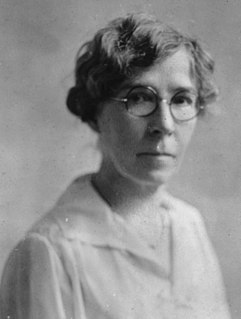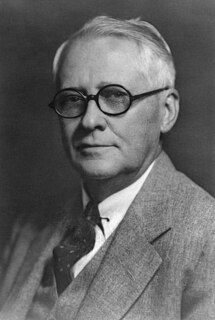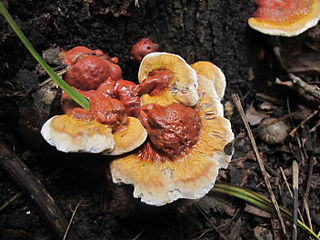Ernst Athearn Bessey was an American mycologist, botanist and plant pathologist who served Professor of Mycology and Botany and Dean of the Graduate School at Michigan State University. He was the son of another famous botanist, Charles Edwin Bessey.

Bjerkandera is a genus of seven species of wood-rotting fungi in the family Meruliaceae.
Lekh Raj Batra was a distinguished mycologist and linguist. He studied the symbiotic relationships of fungi and beetles focusing on ambrosia beetles and fungi, bio-systematics of hemiascomycetes and discomycetes and fungal diseases.

Alma Joslyn Whiffen-Barksdale was a U.S. mycologist who discovered cycloheximide. She was born in Hammonton, New Jersey. She received a bachelor's degree from Maryville College (1937). Her Masters and Ph.D. were earned at the University of North Carolina. In 1941-42. She was a Carnegie Fellow, and in 1951, she was a Guggenheim Fellow. Barksdale worked at the Department of Antibiotic Research of the Upjohn Company of Kalamazoo, Michigan (1943–52) and at the New York Botanical Garden. Barksdale became a foundational figure in the study of Achlya, a genus of aquatic fungi with a unique reproductive system, while working at the New York Botanical Garden; The Mycological Society of America and the Achlya Newsletter, a publication of continuing research on Achlya, both published retrospectives on her life and work following her death in 1981.

Elias Judah Durand was an American mycologist, and botanist. He was one of the foremost American experts on the discomycetes.

Vera Katherine Charles (1877–1954) was an American mycologist. She was one of the first women to be appointed to professional positions within the U.S. Department of Agriculture. Charles coauthored several articles on mushrooms while working for the USDA.
Harry Morton Fitzpatrick,, was an American mycologist. He was professor of mycology at Cornell. He is known for his work on the Phycomycetes. His book on the Lower Fungi was the standard text and reference work on the Phycomycetes. He trained Clark Thomas Rogerson and Richard P. Korf, two prominent mycologists.

Herbert Hice Whetzel was an American plant pathologist and mycologist. As a Professor of Plant Pathology, he led the first department of Plant Pathology at an American university, and founded the Cornell Plant Pathology Herbarium (CUP).
Claude Wilbur Edgerton was an American mycologist. He was born in Woodbine, Iowa, and earned a Bachelor of Science degree from the University of Nebraska in 1903, and a PhD from Cornell University in 1908. After this he was employed at Louisiana State University, initially as a plant pathologist in the Agricultural Research Station, and later as Professor and then Head of Botany, Bacteriology, and Plant Pathology in 1924. Edgerton had this position until his retirement in 1950. He was known for his study of sugarcane diseases; his teaching materials formed the basis of the book Sugarcane and Its Diseases, first published in 1955 after his retirement. Species named in honor of Edgerton include Cryptosporiopsis edgertonii and Synchytrium edgertonii.

Ganoderma sessile is a species of polypore fungus in the Ganodermataceae family. This wood decay fungus is found commonly in Eastern North America, and is associated with declining or dead hardwoods. There is taxonomic uncertainty with this fungus since its circumscription in 1902.

Edith Katherine Cash was an American mycologist and lichenologist.
Arthur Bliss Seymour was an American botanist and mycologist who specialized in parasitic fungi.

David Ross Sumstine was an American educator and mycologist.
Elizabeth Eaton Morse was an American mycologist. Born in Framingham, Massachusetts, she graduated from Ashland, Massachusetts, High School in 1882. For seven years she taught in elementary school before entering Wellesley College, from which she graduated with a diploma from the School of Art in 1891. After twenty years of teaching in the New York City schools Morris High School and Roosevelt High School, she returned to Wellesley College in 1924 and earned a degree in Botany in 1926. Shortly after, she registered as a part-time graduate student in the Department of Botany at the University of California, and was given storage and work space to pursue her interests in cryptogamic botany.
Dr. Martha Christensen was an American mycologist, botanist and educator known as an expert in fungal taxonomy and ecology, particularly for soil-dwelling fungi in the genera Aspergillus and Penicillium.

Meredith May Blackwell is an American mycologist, known as one of the world's leading experts on fungi associated with arthropods.

Sistotrema brinkmannii, a resupinate wood-rotting basidiomycete, is a fungus found in soil, moss, debris, rotten woods as well as woods including seedling roots of Pinus banksiana Lamb. and ectomycorrhizae. No health issues caused by this fungus in human and animals have been reported although it is causative of brown rot. This fungus grows rapidly on malt extract agar (MEA), forming white mats with a faint sweet odour. It is commonly called "chain chlamydospore fungus" because bulbils are formed by chains of its cells that resemble chlamydospores. The basidia of this fungus are urniform and usually possess 6-8 sterigmata, and the spores are smooth and slightly curved.
Irene Mounce was a Canadian scientist who specialized in the mating systems of wood-destroying fungi, Hymenomycetes. She was a mycologist at the Central Experimental Farm, Ottawa, with Canada's federal department of agriculture. Her diligence and insight broke new ground in mycology and her successes made the way easier for other members of her sex.

Sara Bache-Wiig was a Norwegian-born American mycologist and botany professor.










